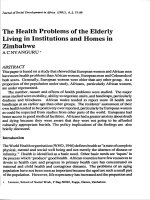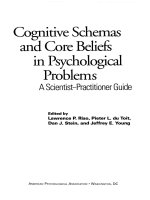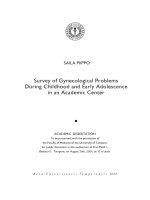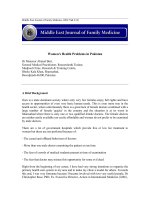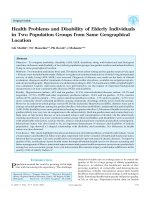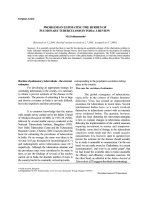150 ECG problems yhocthuchanh2015
Bạn đang xem bản rút gọn của tài liệu. Xem và tải ngay bản đầy đủ của tài liệu tại đây (20.95 MB, 321 trang )
Preface
150
ECG
Problems
For Elsevier
Content Strategist: Laurence Hunter
Content Development Specialist: Helen Leng
Project Manager: Louisa Talbott
Designer/Design Direction: Mark Rogers
Illustration Manager: Jennifer Rose
Illustrators: Helius and Chartwell Illustrators
150
ECG
Problems
FOURTH EDITION
John R. Hampton
DM MA DPhil FRCP FFPM FESC
Emeritus Professor of Cardiology,
University of Nottingham, UK
EDINBURGH LONDON NEW YORK OXFORD PHILADELPHIA ST LOUIS SYDNEY TORONTO 2013
Notices
Knowledge and best practice in this field are constantly changing. As
new research and experience broaden our understanding, changes in
research methods, professional practices, or medical treatment may
become necessary.
© 2013 Elsevier Ltd. All rights reserved.
No part of this publication may be reproduced or transmitted in any
form or by any means, electronic or mechanical, including
photocopying, recording, or any information storage and retrieval
system, without permission in writing from the publisher. Details on
how to seek permission, further information about the Publisher’s
permissions policies and our arrangements with organizations such as
the Copyright Clearance Center and the Copyright Licensing Agency,
can be found at our website: www.elsevier.com/permissions.
This book and the individual contributions contained in it are
protected under copyright by the publisher (other than as may be
noted herein).
First edition 1997
Second edition 2003
Third edition 2008
Fourth edition 2013
ISBN 978-0-7020-4645-2
International ISBN 978-0-7020-4671-1
e-book ISBN 978-0-7020-5245-3
British Library Cataloguing in Publication Data
A catalogue record for this book is available from the British Library
Library of Congress Cataloging in Publication Data
A catalog record for this book is available from the Library of
Congress
Practitioners and researchers must always rely on their own
experience and knowledge in evaluating and using any information,
methods, compounds, or experiments described herein. In using such
information or methods they should be mindful of their own safety
and the safety of others, including parties for whom they have a
professional responsibility.
With respect to any drug or pharmaceutical products identified,
readers are advised to check the most current information provided
(i) on procedures featured or (ii) by the manufacturer of each product
to be administered, to verify the recommended dose or formula, the
method and duration of administration, and contraindications. It is
the responsibility of practitioners, relying on their own experience
and knowledge of their patients, to make diagnoses, to determine
dosages and the best treatment for each individual patient, and to
take all appropriate safety precautions.
To the fullest extent of the law, neither the publisher nor the authors,
contributors, or editors, assume any liability for any injury and/or
damage to persons or property as a matter of products liability,
negligence or otherwise, or from any use or operation of any
methods, products, instructions, or ideas contained in the material
herein.
The
publisher’s
policy is to use
paper manufactured
from sustainable forests
Printed in China
Preface
Learning about ECG interpretation from books such
as The ECG Made Easy or The ECG in Practice is fine
as far as it goes, but it never goes far enough. As with
most of medicine there is no substitute for experience,
and to make the best use of the ECG there is no substitute for reviewing large numbers of them. ECGs
need to be interpreted in the context of the patient
from whom they were recorded. You need to learn to
appreciate the variations of normality and of the patterns associated with different diseases, and to think
about how the ECG can help patient management.
Although no book can be a substitute for practical
experience, 150 ECG Problems goes a stage nearer
the clinical world than books that simply aim to teach
ECG interpretation. It presents 150 clinical problems
in the shape of simple case histories, together with
the relevant ECG. It then invites the reader to interpret the ECG in the light of the clinical evidence
provided, and to decide on a course of action before
looking at the answer. Having seen the answers, the
reader may feel the need for more information, so
each one is cross-referenced to The ECG Made Easy
and/or The ECG in Practice.
The ECGs in 150 ECG Problems range from the
simple to the complex. About one-third of the problems are of a standard that a medical student should
be able to cope with, and should be answered correctly by anyone who has read The ECG Made Easy.
A junior doctor, specialist nurse or paramedic should
get another third right, if they have read The ECG in
Practice. The remainder should challenge the MRCP
candidate. As a very rough guide to the level of difficulty of each problem, each answer is graded using
stars (see the summary box of each answer): one star
represents the easiest records, and three stars the most
difficult.
The ECGs are arranged in random order, not in
order of difficulty, to maintain the reader’s interest.
Readers are invited to attempt their own interpretation before looking at the star rating – after all, in a
real-life situation one never knows which patient will
be easy and which will be difficult to diagnose or
treat.
In this fourth edition there are many new ECGs,
mainly to provide examples that reproduce more
clearly. However, to maintain the “real world”
v
Preface
approach, some technically poor records have deliberately been included. The balance between easy,
moderately difficult and very difficult records has
been maintained.
I am extremely grateful to Alison Gale, my copyeditor, and to Rich Cutler of Helius. Their patience,
understanding and attention to detail made the preparation of this new edition an easy and satisfying
experience for me.
Cross-references
The symbols
vi
indicate cross-references to useful information in the books The ECG Made
Easy, 8th edn, and The ECG in Practice, 6th edn, respectively.
John Hampton
Nottingham, 2013
Introduction: making
the most of the ECG
Recording and reporting an ECG should never be an
end in itself. The ECG is a basic and valuable tool in
the investigation of cardiac problems, and it can be
helpful in the case of non-cardiac problems too, but
it must always be viewed in the context of the patient
from whom the record came. The ECG must never
be a substitute for taking a proper medical history
and carrying out a careful physical examination.
Because it is simple, harmless and cheap, the ECG is
usually the first investigation in a patient with possible cardiac disease and it may be followed by the
plain chest X-ray, the echocardiogram, radionuclide
studies, CT and MR imaging, and cardiac catheterization and angiography – but none of these are substitutes. The ECG, a recording of the electrical activity
of the heart, gives information that can be obtained
in no other way. However, even though it is irreplaceable, it is not infallible.
ECGs are recorded from a wide variety of
patients, in an attempt to help with a wide variety of
possible diagnoses. An ECG is frequently recorded in
the course of ‘health screening’, but here it must be
regarded with considerable caution. It can not be
assumed that individuals who present themselves for
screening are asymptomatic – the process may be
being used as a substitute for a consultation with a
doctor. The ECG itself may cause difficulties of interpretation, for there are a dozen or more normal variants. Minor abnormalities, such as nonspecific ST
segment or T wave changes, will have diagnostic and
prognostic significance if the individual has symptoms that may be cardiac in origin, but these changes
can be of no importance in totally healthy people. It
is rare for an ECG to demonstrate anything of
importance in a totally healthy individual, although
in athletes the detection of abnormalities suggesting
asymptomatic hypertrophic cardiomyopathy is
important.
In patients with chest pain, the ECG is important
but sometimes misleading. It is essential to remember
that the ECG can remain normal for some hours
after the onset of a myocardial infarction. Too often
patients are sent home from an A & E department
because their ECG is normal, despite a reasonably
vii
Introduction
viii
convincing story of ischaemic chest pain. Under such
circumstances the ECG should be repeated several
times to see if changes are appearing, and patient
management should depend on the plasma troponin
level rather than on the ECG. Nevertheless the ECG
is important for deciding treatment in a patient with
chest pain, for the management of a patient with
myocardial infarction with ST segment elevation is
quite different from that of a patient whose ECG
shows a non-ST segment elevation infarction.
Patients with intermittent chest pain that could be
angina frequently have completely normal ECGs at
rest – and then the exercise test can be valuable. The
exercise test is to some extent being replaced by myocardial perfusion scanning for the diagnosis of coronary disease because its predictive accuracy depends
on the likelihood of the patient having angina,
because there can be false negative or false positive
results, and because exercise tests are sometimes unreliable in women. Remember that an exercise test is
safe, but not totally safe, because arrhythmias (including ventricular fibrillation) may be induced. Nev
ertheless the exercise test has the great advantage of
showing a patient’s exercise tolerance, and also
showing what limits his capability.
The ECG also has a role in the investigation of
patients with breathlessness, for it can show changes
associated with heart disease (e.g. an old myocardial
infarction) or with chronic chest disease. Evidence of
left ventricular hypertrophy may point to hypertension, mitral regurgitation or aortic stenosis or regurgitation, and right ventricular hypertrophy may be
the result of pulmonary emboli or mitral stenosis –
however, all of these should have been detected during
the examination of the patient. The ECG is not a
good tool for grading the hypertrophy of the different
heart chambers. It is particularly important to remember that the ECG cannot demonstrate heart failure: it
may suggest a condition that may cause heart failure,
but is impossible to determine from an ECG whether
a patient is in heart failure or not. However, in the
presence of a completely normal ECG, heart failure
is certainly unlikely.
There are characteristic ECG appearances in several
conditions that are not primarily cardiac – for example
with severe electrolyte derangement. ECG monitoring
is not an acceptable way of following electrolyte
changes in conditions such as diabetic ketoacidosis,
but at least any abnormalities may prompt the appropriate biochemical tests. The ECG has, however,
become important in the development of new drugs,
for any drug that causes QT prolongation – and this
is by no means uncommon – may cause sudden death
due to ventricular tachycardia.
It is in the investigation and management of patients
with possible arrhythmias that the ECG is of paramount importance. Patients may complain of palpitations or dizziness and syncope as a result of rhythm
disturbances, and there is no way of identifying these
with certainty other than with an ECG. Dizziness and
syncope can be the result of rhythms that are either
too fast or too slow for an effective cardiac output, or
of slow rhythms associated with disorders of conduction. There may be little in the patient’s history to point
specifically to a cardiac problem when dizziness or
collapse is the main symptom, but an appropriately
abnormal ECG may immediately point to the right
diagnosis. When a patient complains of palpitations
there is a clearly a heart problem of some sort, and it
is usually possible to come close to a diagnosis by
taking a careful history – the patient with extrasystoles
will describe the heart ‘jumping out of the chest’ or
something equally unlikely, and the problem will be
worse when lying down at night, and after smoking
and alcohol. The patient with a true paroxysmal
tachycardia will describe the sudden onset (and sometimes the sudden cessation) of the rapid heartbeat, and
if the attack is associated with chest pain, dizziness or
breathlessness then the presence of a paroxysmal
tachycardia becomes highly likely.
Introduction
Few patients will have their arrhythmia at the time
they are seen, but the ECG can still give valuable clues
to its nature. A patient whose ECG shows bifascicular
block, or first degree atrioventricular block together
with left bundle branch block, may have intermittent
complete block and Stokes–Adams attacks. A patient
whose ECG shows pre-excitation (the Wolff–Parkinson–White or Lown–Ganong–Levine syndromes) is at
risk of paroxysmal arrhythmias – though many
people with these ECG patterns never have any problems at all. A patient with a prolonged QT syndrome,
as a result of either a congenital defect or drug treatment, is at risk of torsade de pointes ventricular
tachycardia. Under all these circumstances, ambulatory ECG recording, by one of a variety of techniques, may demonstrate the true nature of the
arrhythmia that causes the symptoms – but it must
be remembered that many, if not most, arrhythmias
will be seen transiently in completely healthy people
and only when an abnormal ECG corresponds
to symptoms can one be certain that the two are
related.
So the way to approach the ECG, and this book
– and indeed any medical situation – is to start with
the patient. If you cannot make a reasonable diagnosis from the history, and to a lesser extent the examination, the chances of doing so as a result of
investigations are not great. The role of the ECG and
of more complex investigations is to help differentiate
between the various possible diagnoses suggested by
talking to, and examining, the patient. The clinical
scenarios given with each ECG in this book are of
necessity brief, but think about them, ask yourself
what the diagnosis might be, and then describe and
report on the ECG. That is the way to make the most
of the ECG.
ix
This page intentionally left blank
I
VR
V1
V4
II
VL
V2
V5
III
VF
V3
V6
ECG 1
ECG 1
This ECG was recorded from a 20-year-old student
who complained of an irregular heartbeat. Apart from
an irregular pulse, her heart was clinically normal.
What do the ECG and chest X-ray show and what
would you do?
1
ANSWER 1
The ECG shows:
•Sinus rhythm, rate 100/min
•Ventricular extrasystoles
•Normal axis
•Normal QRS complexes and T waves
The chest X-ray is normal.
Clinical interpretation
The extrasystoles are fairly frequent but the ECG is otherwise normal.
What to do
Ventricular extrasystoles are very common. In large groups of people, there is a
correlation between the presence of extrasystoles and heart disease of many types.
However, in young people who are otherwise asymptomatic and whose hearts are
otherwise normal, the chances of a significant cardiac problem are very low.
In a young woman it is worth checking the haemoglobin level. An echocardiogram might set her mind at rest, but is not essential. The important thing is to advise
her not to smoke and to avoid alcohol, coffee and tea.
Summary
Sinus rhythm with ventricular extrasystoles.
See p. 64, 108, 8E
2
See p. 7, 6E
I
VR
V1
V4
II
VL
V2
V5
III
VF
V3
V6
ECG 2
ECG 2
A 60-year-old man was seen as an outpatient, complaining of rather vague central chest pain on exertion. He
had never had pain at rest. What does this ECG show and what would you do next?
3
ANSWER 2
The ECG shows:
•Sinus rhythm, rate 77/min
•Normal PR interval
•Normal axis
•Prominent and deep Q waves in leads II, III and VF, indicating an inferior
infarction. There are also small Q waves in leads V5–V6, but these may be septal
•ST segments normal, with no elevation in the leads showing Q waves
•Inverted T waves in leads II, III and VF
Clinical interpretation
The Q waves in the inferior leads, together with inverted T waves, point to an old
inferior myocardial infarction.
What to do
The patient seems to have had a myocardial infarction at some point in the past,
and by implication his vague chest pain may be due to angina. Attention must be
paid to risk factors (smoking, blood pressure, plasma cholesterol), and he probably
needs long-term treatment with aspirin and a statin. An exercise test or a perfusion
scan will be the best way of deciding whether he has coronary disease that merits
angiography.
Summary
Old inferior myocardial infarction.
See p. 91, 8E
4
See p. 215, 6E
I
VR
V1
V4
II
VL
V2
V5
III
VF
V3
V6
ECG 3
ECG 3
II
An 80-year-old woman, who had previously had a few attacks of dizziness, fell and broke her hip. She was found
to have a slow pulse, and this is her ECG. The surgeons want to operate as soon as possible but the anaesthetist
is unhappy. What does the ECG show and what should be done?
5
ANSWER 3
The ECG shows:
•P wave rate 130/min
•Complete heart block
•Ventricular (QRS complex) rate 23/min
•The ventricular ‘escape’ rhythm has wide QRS complexes and abnormal T
waves
No further interpretation of the ECG is possible.
Clinical interpretation
In complete heart block there is no relationship between the P waves (here with
a rate of 120/min) and the QRS complexes.
What to do
In the absence of a history suggesting a myocardial infarction, this woman almost
certainly has chronic heart block: the fall may or may not have been due to a
Stokes–Adams attack. She needs a permanent pacemaker, ideally immediately. If
permanent pacing is not possible immediately, a temporary pacemaker will be
needed preoperatively.
Summary
Complete (third degree) heart block.
See p. 41, 8E
6
See p. 179, 6E
I
VR
V1
V4
II
VL
V2
V5
III
VF
V3
V6
ECG 4
ECG 4
A 50-year-old man is seen in the A & E department with severe central chest pain which has been present for
18 h. What does this ECG show and what would you do?
7
ANSWER 4
The ECG shows:
•Sinus rhythm, rate 64/min
•Normal axis
•Q waves in leads V2–V4
•Raised ST segments in leads V2–V4
•Inverted T waves in leads I, VL, V2–V6
Clinical interpretation
This is a classic acute ST segment elevation anterior myocardial infarction (STEMI).
What to do
More than 18 h have elapsed since the onset of pain, so this patient is outside the
conventional limit for thrombolysis or percutaneous coronary intervention (PCI).
Nevertheless, if he is still in pain and still looks unwell, PCI or thrombolytic treatment should be given unless there are good reasons not to do so. In any case, he
should be given pain relief and aspirin, and must be admitted to hospital for
observation.
Summary
Acute anterior STEMI.
See p. 91, 92, 8E
8
See p. 217, 6E
I
VR
V1
V4
II
VL
V2
V5
III
VF
V3
V6
ECG 5
ECG 5
II
This ECG was recorded from a 60-year-old woman with rheumatic heart disease. She had been in heart failure,
but this had been treated and she was no longer breathless. What does the ECG show and what question might
you ask her?
9
ANSWER 5
The ECG shows:
•Atrial fibrillation with a ventricular rate of about 80/min
•Normal axis
•Normal QRS complexes
•Downward-sloping ST segments, best seen in leads V5–V6
•Prominent U waves in leads V2–V3
Clinical interpretation
The downward-sloping ST segments (the ‘reverse tick’) indicate that digoxin has
been given. The ventricular rate seems well controlled. The prominent U waves in
leads V2–V3 are probably normal: U waves due to hypokalaemia are associated with
flattened T waves.
What to do
Ask the patient about her appetite: the earliest symptom of digoxin toxicity is
appetite loss, followed by nausea and vomiting. If the patient is being treated with
diuretics, check the serum potassium level – a low potassium level potentiates the
effects of digoxin. If in doubt, the serum digoxin level is easily measured.
Summary
Atrial fibrillation with digoxin effect.
See p. 76, 101, 8E
10
See p. 335, 6E
I
VR
V1
V4
II
VL
V2
V5
III
VF
V3
V6
ECG 6
ECG 6
A 26-year-old woman, who has complained of palpitations in the past, is admitted to hospital via the A & E
department with palpitations. What does the ECG show and what should you do?
11
ANSWER 6
The ECG shows:
•Narrow complex tachycardia, rate about 200/min
•No P waves visible
•Normal axis
•Regular QRS complexes
•Normal QRS complexes, ST segments and T waves
Clinical interpretation
This is a supraventricular tachycardia, and since no P waves are visible this is a
junctional, or atrioventricular nodal re-entry, tachycardia (AVNRT).
What to do
AVNRT is the commonest form of paroxysmal tachycardia in young people, and
presumably explains her previous episodes of palpitations. Attacks of AVNRT may
be terminated by any of the manoeuvres that lead to vagal stimulation – Valsalva’s
manoeuvre, carotid sinus pressure, or immersion of the face in cold water. If these
are unsuccessful, intravenous adenosine should be given by bolus injection. Adenosine has a very short half-life, but can cause flushing and occasionally an asthmatic
attack. If adenosine proves unsuccessful, verapamil 5–10 mg given by bolus injection will usually restore sinus rhythm. Otherwise, DC cardioversion is indicated.
Summary
Atrioventricular nodal re-entry (junctional) tachycardia (AVNRT).
See p. 81, 8E
12
See p. 109, 6E
I
VR
V1
V4
II
VL
V2
V5
III
VF
V3
V6
ECG 7
ECG 7
This ECG was recorded in the A & E department from a 55-year-old man who had had chest pain at rest for 6 h.
There were no abnormal physical findings, and his plasma troponin level was normal. What does the trace show,
and how would you manage him?
13
ANSWER 7
The ECG shows:
•Sinus rhythm, rate 130/min
•Normal axis
•Normal QRS complexes
•ST segment depression – slightly upward-sloping in lead V3, downward-sloping
in leads I, VL, V4–V6
Clinical interpretation
This ECG shows anterior and lateral ischaemia without evidence of infarction.
Taken with the clinical history, the diagnosis is clearly ‘unstable’ angina.
What to do
There is no evidence that he would benefit from thrombolysis: percutaneous coronary intervention (PCI) would probably be the treatment of choice. Immediately,
however, he needs a beta-blocker to bring his heart rate down. Although the normal
troponin level suggests that he has not (yet) had a myocardial infarction, in view
of the length of the history it would be prudent to treat him with aspirin, heparin
and a statin.
Summary
Anterolateral ischaemia.
See p. 144, 8E
14
See p. 212, 6E



